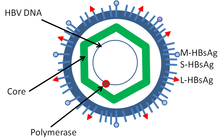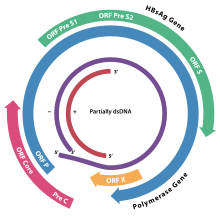HBcAg
| Capsid protein | |||||||
|---|---|---|---|---|---|---|---|
| Identifiers | |||||||
| Organism | |||||||
| Symbol | C | ||||||
| UniProt | Q9QAB9 | ||||||
| |||||||
| Hepatitis core antigen | |||||||||
|---|---|---|---|---|---|---|---|---|---|
| Identifiers | |||||||||
| Symbol | Hepatitis_core | ||||||||
| Pfam | PF00906 | ||||||||
| InterPro | IPR002006 | ||||||||
| CATH | 7abl | ||||||||
| SCOP2 | 7abl / SCOPe / SUPFAM | ||||||||
| |||||||||


HBcAg (core antigen) is a hepatitis B viral protein.[1][2] It is an indicator of active viral replication; this means the person infected with Hepatitis B can likely transmit the virus on to another person (i.e. the person is infectious).
Structure and function
[edit]HBcAg is an antigen that can be found on the surface of the nucleocapsid core (the inner most layer of the hepatitis B virus). While both HBcAg and HBeAg are made from the same open reading frame, HBcAg is not secreted as a monomer.[3] HBcAg is considered "particulate" and it does not circulate in the blood, but recent study show it can be detected in serum by Radioimmunoassay. However, it is readily detected in hepatocytes after biopsy.[4] When both HBcAg and HBeAg proteins are present, it acts as a marker of viral replication.[5]
HBcAg, also called core protein (Cp), is a 21 kDa protein of 183-185 amino acids, depending on the genotype, and is the result of the second start codon in the open reading frame.[6] Once a threshold of HBcAg proteins are translated in the cytoplasm, the viral capsid will spontaneously into a T=3 or T=4 icosahedral capsid.[7] The capsid will usually package the hepatitis B genomic RNA, but some capsids will have cellular RNA or be empty.[8] HBcAg is the target of antiviral compounds, termed capsid assembly modulators (CAMs), that are under clinical investigation for treating chronic hepatitis B.[9]
Interactions
[edit]Tapasin can interact with HBcAg18-27 and enhance cytotoxic T-lymphocyte response against HBV.[10]
See also
[edit]References
[edit]- ^ Kimura T, Rokuhara A, Matsumoto A, et al. (May 2003). "New enzyme immunoassay for detection of hepatitis B virus core antigen (HBcAg) and relation between levels of HBcAg and HBV DNA". J. Clin. Microbiol. 41 (5): 1901–6. doi:10.1128/JCM.41.5.1901-1906.2003. PMC 154683. PMID 12734224.
- ^ Cao T, Meuleman P, Desombere I, Sällberg M, Leroux-Roels G (December 2001). "In vivo inhibition of anti-hepatitis B virus core antigen (HBcAg) immunoglobulin G production by HBcAg-specific CD4(+) Th1-type T-cell clones in a hu-PBL-NOD/SCID mouse model". J. Virol. 75 (23): 11449–56. doi:10.1128/JVI.75.23.11449-11456.2001. PMC 114731. PMID 11689626.
- ^ McFadden, William M.; Sarafianos, Stefan G. (2023). "Biology of the hepatitis B virus (HBV) core and capsid assembly modulators (CAMs) for chronic hepatitis B (CHB) cure". Global Health & Medicine. 5 (4): 199–207. doi:10.35772/ghm.2023.01065. PMID 37655181.
- ^ Wang, Jie; Shen, Tao; Huang, Xiangbo; Kumar, G. Renuka; Chen, Xiangmei; Zeng, Zhenzhen; Zhang, Ruiyang; Chen, Ran; Li, Tong; Zhang, Tianying; Yuan, Quan; Li, Pao-Chen; Huang, Qi; Colonno, Richard; Jia, Jidong; Hou, Jinlin; McCrae, Malcolm A.; Gao, Zhiliang; Ren, Hong; Xia, Ningshao; Zhuang, Hui; Lu, Fengmin (2016). "Serum hepatitis B virus RNA is encapsidated pregenome RNA that may be associated with persistence of viral infection and rebound". Journal of Hepatology. 65 (4): 700–710. doi:10.1016/j.jhep.2016.05.029. PMID 27245431.
- ^ Wong, Danny Ka-Ho; Tanaka, Yasuhito; Lai, Ching-Lung; Mizokami, Masashi; Fung, James; Yuen, Man-Fung (2007). "Hepatitis B Virus Core-Related Antigens as Markers for Monitoring Chronic Hepatitis B Infection". Journal of Clinical Microbiology. 45 (12): 3942–3947. doi:10.1128/jcm.00366-07. PMC 2168562. PMID 17942661.
- ^ Selzer, Lisa; Zlotnick, Adam (2015). "Assembly and Release of Hepatitis B Virus". Cold Spring Harbor Perspectives in Medicine: a021394. doi:10.1101/cshperspect.a021394. PMID 26552701.
- ^ Zlotnick, Adam (2005). "Theoretical aspects of virus capsid assembly". Journal of Molecular Recognition. 18 (6): 479–490. doi:10.1002/jmr.754. PMID 16193532.
- ^ Liu, Kuancheng; Hu, Jianming (2019). "Secretion of Empty or Complete Hepatitis B Virions: Envelopment of Empty Capsids Versus Mature Nucleocapsids". Future Virology. 14 (2): 95–105. doi:10.2217/fvl-2018-0128.
- ^ McFadden, William M.; Sarafianos, Stefan G. (2023). "Biology of the hepatitis B virus (HBV) core and capsid assembly modulators (CAMs) for chronic hepatitis B (CHB) cure". Global Health & Medicine. 5 (4): 199–207. doi:10.35772/ghm.2023.01065. PMID 37655181.
- ^ Chen X (May 2014). "Tapasin modification on the intracellular epitope HBcAg18-27 enhances HBV-specific CTL immune response and inhibits hepatitis B virus replication in vivo". Lab. Invest. 94 (5): 478–90. doi:10.1038/labinvest.2014.6. PMID 24614195.
